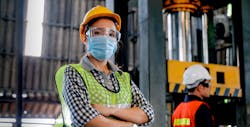As Factories Reopen, What Role Can AI Play in Worker Safety?
As the country begins to slowly reopen from the COVID-19 lockdown, many people are heading back to work. While this is great for the nation’s supply chains and overall economy, a growing concern exists for an increase in the risk of transmission and the likelihood of cluster outbreaks within the workforce. This has the potential to not only compromise the health of staff members, but close facilities for weeks at a time and halt operations.
In an effort to mitigate this, many management teams are working to produce health and safety guidelines, like the mandatory wearing of personal protective equipment (PPE) and social distancing protocols to reduce the risk of cluster COVID-19 outbreaks. These guidelines, however, can only go so far, as it takes strict enforcement to ensure that personnel adhere to them—and compliance teams may already be stretched thin.
Advancements in artificial intelligence (AI) and the IoT have enabled a number of technologies to emerge that have the potential to keep workplaces healthier and safer through PPE detection, safety zoning and thermal imaging capabilities.
Here’s what this might look like in practice.
Imagine: as employees arrive at their companies, workers place an industrial-grade wearable device on their wrists, put on their PPE and get to work. Over the course of the workday, as employees become consumed in the task at hand, they accidentally step closer than 6 feet to their colleagues or remove their PPE to scratch their face and fail to put it back on properly. The AI, utilizing high definition cameras, notices this and sends a gentle reminder to the employee via their wearable to keep six feet away or replace their PPE, while sending another notification to the manager, which enables them to identify staff members who may require additional coaching. On top of this, thermal imaging capabilities routinely capture employees’ temperature throughout the day, detecting possible fevers and alerting management so the employee can be quarantined and sent for testing as quickly as possible.
Furthermore, recently updated OSHA regulations state that businesses are expected to investigate and collect evidence of any business-related COVID-19 infections. This means businesses must delve into positive infection diagnoses among staff to determine whether the infection occurred at work, while also reviewing the work environment to identify any further potential COVID-19 exposures, including personnel who work in close proximity to the infected staff member. The implementation of this AI and IoT technology means that employers already have a well-recorded ‘paper trail’ through which they can base their investigation.
The importance of early detection and investigation in preventing cluster outbreaks can’t be understated, and that’s why technology that enforces strict compliance can play an important role throughout the reopening phase. A great example of how effective strict compliance is in keeping primary producers, manufacturers, and distribution centers running can be found in Germany, where stringent health and safety compliance procedures such as PPE guidelines, social distancing, and contact tracing have enabled German industry to keep running throughout the pandemic. One major company only experienced 15 cases of infection out of their 6,700 employees, and that was credited to their following of strict protocols.
Outside of infection control, these AI technologies have shown potential to enhance workplace safety in other ways. Some providers offer fall detection, vehicle collision detection and thermal imaging capabilities that capture the temperature of a space and not just the individuals within it to deliver alerts for when workplaces become hazardous. These capabilities demonstrate that the implementation of this technology can still deliver health and safety benefits in most industrial settings long after the pandemic has ended.
While the pandemic is still far from over and there are sure to be some adjustment pains in reopening workplaces with new protocols in place, AI presents us with a clear solution. Through enforcing guidelines around the wearing of PPE, ensuring social distancing and thermal imaging capabilities, AI has the potential to reduce transmission, ensure the health and safety of staff members, and detect—and contain—cluster outbreaks before they start, especially since experts claim global viral outbreaks will now become more common.
Mark Bula is chief strategy officer (CSO) and general manager (GM) of steel at Everguard.ai, a developer of AI-based worker safety solutions. The company incorporates computer vision, machine learning and AI to provide a real-time platform to improve productivity and safety.
